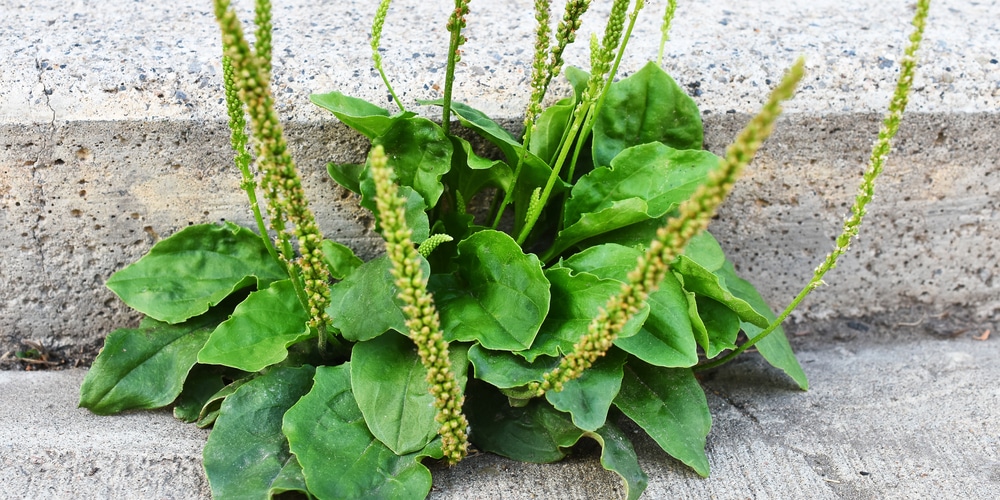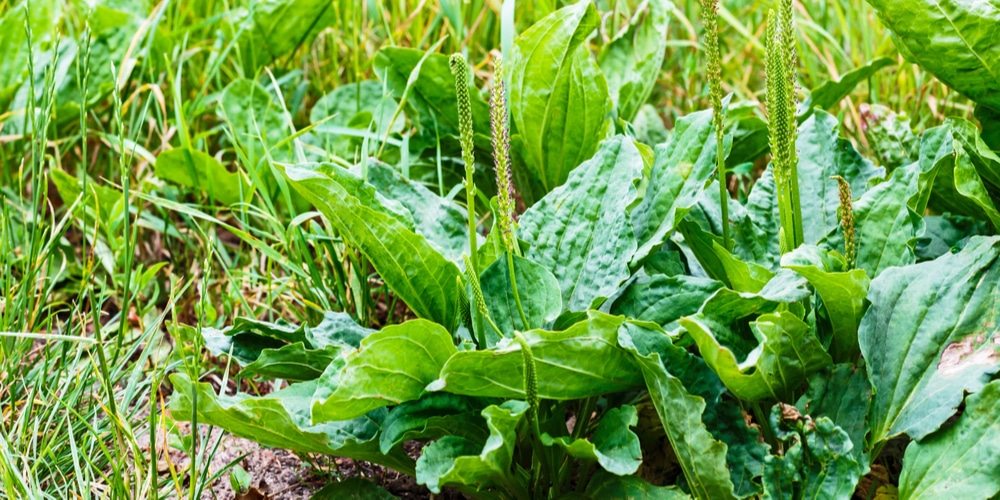Broadleaf plantain is one of the most troublesome perennial weeds gardeners have to deal with. While it is safe to eat and loaded with essential nutrients and overall health-promoting qualities, you don’t have to put up with its presence on your lawn.
If broadleaf plantain is growing on your lawn, it is a good idea to remove it as soon as you can to prevent spread. Read on to learn more about this pesky weed and how to get rid of it.
What is broadleaf plantain?

Broadleaf plantains (Plantago major) is a versatile perennial weed. It is not picky about growing and lighting conditions but prefers full sun and compacted soil. You can find broadleaf plantain growing in your lawn, sidewalks, or along roadsides.
As the name suggests, broadleaf plantains sport smooth, dark green, wide, oval leaves 3-7 inches long. The leaves have 3-5 prominent parallel veins and usually lie flat to the ground. They have shallow taproots that keep them alive in most conditions.
In early to mid-summer, these weeds will send up long, narrow flower stalks crowned with dense spikes of small flowers. The flowers will bloom, and seeds will be dispersed by wind. Surprisingly, a healthy broadleaf plantain can produce up to 14,000 seeds per year, and seeds can remain viable in the soil for over 60 years.
Because broadleaf plantains are adept at spreading by seeding, they can easily dominate any lawn if not controlled.
Getting rid of broadleaf plantains
Broadleaf spreads by seed, so eliminating them before seed dispersal is an easy way to prevent proliferation. Here are effective methods for eradicating broadleaf plantains:
1. Uprooting or digging out
Uprooting by pulling or diligently digging weeds out is considered the most environment-friendly way of getting rid of pesky weeds.
Plantains have shallow taproots, and you want to make sure you remove the entire root without leaving even the tiniest bit of it. This is very crucial because these weeds survive and re-grow if you don’t get their whole root system out.
If you elect to pull up broadleaf plantains, water the area well one day before uprooting.
Once the ground is soft, loosen the soil around the taproot and pull out the plant once the root seems free. Because there are chances of leaving very tiny bits of roots when pulling, you may have to dig and pull several times before achieving complete control.
Notably, digging out and pulling will deliver the best results if done before the weeds start producing seeds.
2. Treating with weed killers
If handpicking is not working or practical because of severe invasions, it is time to spray weed killer on the plants. Thankfully, there are a lot of broadleaf herbicides that kill the weeds without hurting your grass.
You can go for a fast-acting ortho or round-up weed killer. They both do a great job of controlling these pesky weeds as their active ingredients go down into the root system to kill the plants completely.
To get rid of broadleaf plantains using herbicides, carefully follow the manufacturer’s instructions regarding mixing, timing, and application procedures. With most herbicides, you need to spray the mixture lightly on the leaves and repeat application every 1-2 weeks. Avoid spraying weed killers a few minutes before rainfall, when it is very hot (above 85 degrees Fahrenheit), or when there are strong winds.
Weed killers designed for eliminating broadleaf plantain should wipe out the weeds without harming your grass or flowers.
Of significance, broadleaf plantains are quite stubborn, so make sure to follow the manufacturer’s instructions. Otherwise, the weeds may return.
How to prevent broadleaf plantains in your lawn
If broadleaf plantains are growing in your lawn, it is a telltale sign that you have compacted soil. Plantains also thrive in sparse or too-closely mowed lawns.
Consider these tips to keep them from coming back:
- Keep your lawn and garden soil aerated and healthy
- Maintain a thick, lush lawn by feeding your grass as needed at least twice yearly. Fertilizing your lawn keeps it healthy enough to fight weed development and even diseases.
- Water your lawn deeply but infrequently, especially when there is less than an inch of rainfall per week
- Mow regularly at the height best for your grass. You can leave the grass clippings to recycle nutrients back into the soil.
Broadleaf plantain is a stubborn and ugly weed that thrives in a range of conditions. Staying on top of lawn maintenance practices should help keep them away after removing them.
How to get rid of broadleaf plantain weeds: Conclusion
Broadleaf has a reputation thanks to its pain-relieving properties and host of health-promoting qualities. The biggest catch is how obstructive it looks in your lawn.
Unless you want to sacrifice your lawn’s beauty for plantain’s benefits, getting rid of it whenever it pops up in your garden is a good idea. Hopefully, this guide helps you to eradicate and prevent broadleaf plantains from growing on your lawn.
